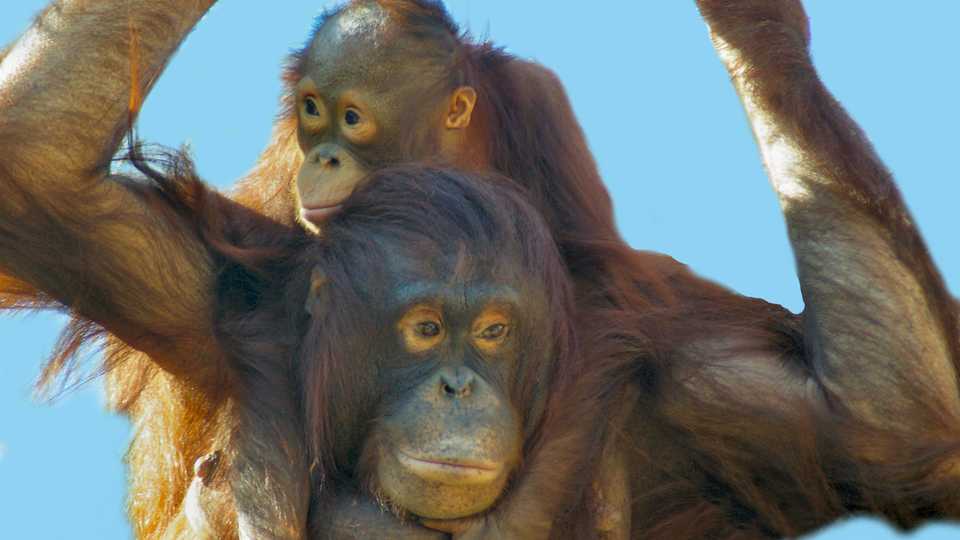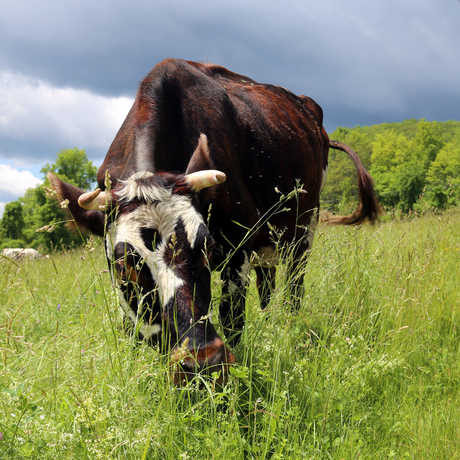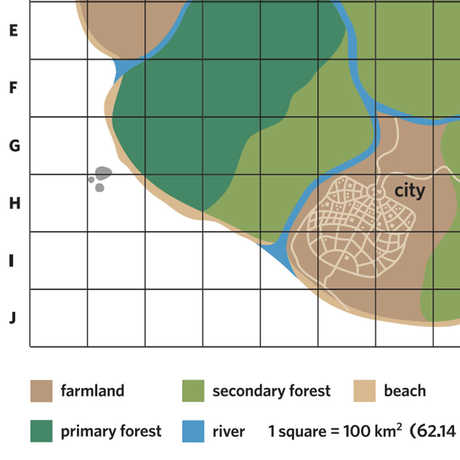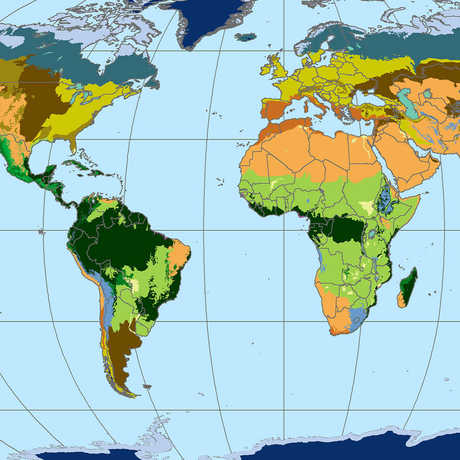
Become a Rainforest Action Hero! Learn how you and your students can help protect primates.
Students will be able to:
- Identify the common characteristics of primates that allow them to survive in their environments.
- Explore how changes in the environment can affect the survival rate of certain organisms in an ecosystem.
- Come up with at least one action item to help protect primates in the natural world.
- butcher paper (one large piece per group)
- pencils (one per student)
- markers (one set per group)
- rulers or meter sticks (one per group)
- tape (one roll)
- scissors (one pair per group)
- magnifying glasses (optional)
- primate cards (pdf)
- primate and/or rainforest books (optional)
- palm oil activity handout (pdf)
- Print attached primate cards (lemurs from Madagascar, howler monkeys from Costa Rica, squirrel monkeys from the Amazon, and orangutans from Borneo).
- Cut out one 5-5 ½ foot long piece of butcher paper per student group.
- Assign your groups of 4 beforehand.
- Pass out one species of primate cards to each group. Let them know that they are going to explore how they (the students) are similar and different to the primates on the cards.
- Have students make observations of their primate cards within groups. Have students discuss characteristics they notice and things they wonder about their specific primate (hairy, furry, long arms, big eyes, and live in trees).
- Then ask students to discuss why those characteristics might be important to have.
- As a group share those characteristics and write them on the board. Discuss possible reasons for these characteristics.
- Have students think about the following question in groups: “How do primate characteristics relate to or connect to human characteristics?”
Teacher Tip: Reasons for primate characteristics include, but are not limited to: eyes centered in the front of the head creates an overlapping field of vision which gives the brain more information for both close and far away images, opposable thumb on hands and feet help to grasp objects, solid ball and socket joint in the shoulder and a collarbone that allows hanging and swinging from branches, and shortened nose and muzzle to emphasize using sight instead of smell to capture prey or escape predators.
- Explain to students that they will be comparing their own characteristics to the primate species on their cards.
- Ask one student per group to lie down on top of the butcher paper.
- Remaining group members help trace the student’s body on the paper with a pencil.
- The groups use their primate cards for reference and label similar characteristics they observe between themselves and the primate picture onto their butcher paper.
- Have students write I wonder questions about the primates beneath their drawings.
- In their groups, have students think about what these animals might need in order to survive (type of habitat, food, etc.).
- Allow students to then choose one of their questions to research by using informational text.
- Display drawings throughout the class, discuss similarities and differences and have students share their questions and what they learned.
- For example, why do some of the monkeys have tails and others don't? How might that characteristic be useful to that animal.
- For this part of the activity, your focus is on the orangutan’s habitat and how palm oil is having an effect on its habitat.
- Print out a couple images of palm oil to share with the class as a whole.
- If you have bought products with palm oil, think how you’re going to divide the class (in groups of 4) to have them investigate the ingredients on the snack items. Otherwise, ask students to keep any snack wrappers from the day of or day before.
- The list of companies who adhere to (or do not) sustainable palm oil is your own resource to supplement your class discussion. You may print this as well.
- Have students observe a picture of a healthy rainforest (flickr photo in Reference).
Teacher Tip: Allow students to make observations with I notice and I wonder statements for both pictures.
- Transition into showing what an unhealthy rainforest looks like (flickr photo in Reference).
Teacher Tip: Allow students to make observations with I notice and I wonder statements for both pictures. Both photos were taken in Malaysia.
- Inform students that many primates are endangered or threatened and are losing their habitats for many reasons- one of them being deforestation to make room for palm oil plantations.
Teacher Tip: An example is that of deforestation of a Southeast Asian rainforest for palm oil production and its negative affects to the orangutan. You may show the class the infographic of deforestation and its effects on wildlife.
- Give examples of everyday items that contain palm oil with an emphasis on food/snack items (check References).
Part 1: Girl Scout Story/Sustainable Palm Oil
- Share the incredible story of how two girl scouts voiced their concerns about their Girl Scout cookies containing palm oil and in return were able to get sustainable palm oil to replace the non-sustainable palm oil in the Girl Scout cookies. Find the story in the References section at the end of this lesson.
- Tell students that they will be carefully looking to see how they also can help out in their homes with their families.
Part 2: Rainforest Action Hero: check the ingredients
- Inform students they will be Rainforest Action Heroes (!) by checking the ingredients of products to see which items have palm oil and which don’t.
- If snacks were purchased for this part of the activity split class into groups. On the board, write the other names palm oil goes by. If students have store-bought snacks, direct them to read the ingredients on their snacks as well to search for palm oil.
Teacher Tip: Alternative names for palm oil include: palm oil kernel, palmitate/palmate, elaeis gunieensis, hydrated palm glycerides hexadecanoic, palmitic acid, and any vegetable oils with saturated fats.
- Have students use a magnifying glass to find ingredients in products that are not rainforest friendly.
- Create a chart as a class, of snacks/candy bars to show those items with no palm oil and/or sustainable palm oil vs. non-sustainable palm oil and have students discuss the data.
- Talk about good alternatives to palm oil and share companies and their products that are adhering to sustainable practices for growing palm oil. Use information from your Palm Oil Scorecard resource found below in References.
Teacher Tip: Palm oil is in many packaged food items, as well as cleaning and cosmetic products. Finding alternatives is difficult, the best solution is to check labels to see if palm oil is present, or look for labeling of sustainability, and eating non-processed foods.
- Commitment: Thank students for being Rainforest Action Heroes! Encourage students to continue to take action by asking students if they would be willing to check their labels for palm oil the next time they go to the store. Pass out palm oil handout to help encourage your Rainforest Action Heroes!
Discuss as a class how students can take action to protect primates before talking about the following:
- Only buy sustainably produced rainforest products, or eat local fruits and vegetables
- Write letters to conservation groups and politicians
- If possible, volunteer for conservation organizations and/or donate money
- Help spread the word to friends and family
- Discuss how rainforests are important and why these beautiful creatures help this ecosystem.
- As a way to integrate English Language Arts, have students write letters to conservation groups and/or politicians expressing their concern for the future of tropical rainforest primates.
Science and Engineering Practices
- Asking Questions and Defining Problems: Ask questions that can be investigated and predict reasonable outcomes based on patterns such as cause and effect relationships.
Disciplinary Core Ideas
- LS2.C Ecosystem Dynamics, Functioning, and Resilience: When the environment changes in ways that affect a place’s physical characteristics, temperature, or availability of resources, some organisms survive and reproduce, others move to new locations, yet others move into the transformed environment, and some die.
- LS4.D Biodiversity and Humans: Populations live in a variety of habitats, and change in those habitats affects the organisms living there.
Crosscutting Concepts
- Cause and Effect (3-5): Cause and effect relationships are routinely identified, tested, and used to explain change.
Grade 3
Life Sciences
3. Adaptations in physical structure or behavior may improve an organism’s chance for survival. As a basis for understanding this concept:
a.Students know plants and animals have structures that serve different functions in growth, survival, and reproduction.
d. Students know when the environment changes, some plants and animals survive and reproduce; other die or move to new locations.
Grade 4
Life Sciences
3. Living organisms depend on one another and on their environment for survival. As a basis for understanding this concept:
b.Students know that in any particular environment, some kinds of plants and animals survive well, some survive less well, and some cannot survive at all.
The Dodo (February 17, 2014). Girl Scouts Demand Sustainable Palm Oil for Cookies to Save Orangutans. Retrieved May 7, 2015 from https://www.thedodo.com/girl-scouts-demand-sustainable-433365522.html
Encyclopedia Britannica. (September 10, 2014). “Primate.” Retrieved October 15, 2014, from http://www.britannica.com/EBchecked/topic/476264/primate
Luke Price. Jungle. Sarawak, Borneo, Malaysia. June 27, 2014. flickr.com. Retrieved August 21, 2015 from https://www.flickr.com/photos/lukeprice88/14766487031/
Project Orangs. Girl Scouts Demand Sustainable Palm Oil for Cookies to Save Orangutans. Retrieved August 21, 2015 from http://projectorangs.org/.
Rainforest Rescue. (2014). Palm Oil: Facts about the ingredients that destroys the rainforests. Retrieved May 7, 2015 https://www.rainforest-rescue.org/files/en/palm-oil-download.pdf
Union of Concerned Scientists. Infographic: Palm Oil and Tropical Deforestation. Retrieved August 21, 2015 from http://www.ucsusa.org/global_warming/solutions/stop-deforestation/palm-oil-infographic.html#.VdYXSJdSX39
Vincentraal. DSC_2331.jpg. Taken on May 14 2009. flickr.com. Retrieved August 21, 2015 from https://www.flickr.com/photos/vincentraal/8150208448/in/album-72157631903852569/
Lael K. Goodman & Asha R. Sharma. Fries, Face Wash, Forests. Scoring America’s Top Brands on Their Palm Oil Commitments. April 2015. http://www.ucsusa.org/sites/default/files/attach/2015/04/ucs-palm-oil-scorecard-2015.pdf
World Wildlife Fund. (January 2, 2008). Orangutan Plan to Curb Carbon Emissions. Science Daily. Retrieved February 15, 2008 from http://www.sciencedaily.com/releases/2007/12071213204034.html


